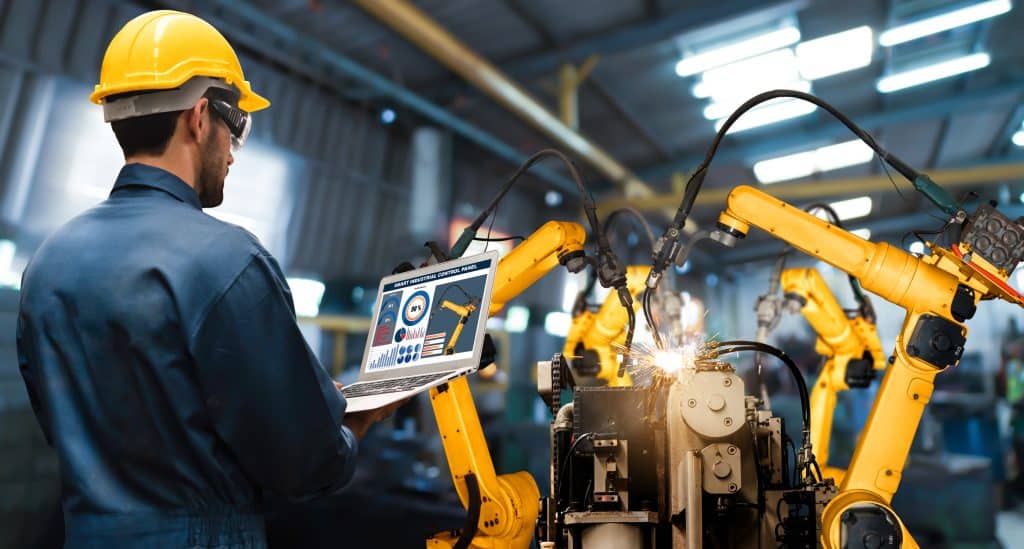The introduction of collaborative robots, the use of artificial intelligence and advances in 3D printing will continue to change the manufacturing landscape.

As manufacturers look for increased efficiencies, more streamlined operations and greater cost saving, many are looking into innovative, advanced manufacturing technologies. The synergies between the industrial automation and manufacturing have always been important to both, but the current labor crisis has intensified the sense of urgency. Statistics show that around 750,000 jobs are unfilled in this sector, and it is estimated that 2.1 million manufacturing jobs will remain unfilled by 2030.
Addressing the skills gap is just one of the major drivers of digital transformation. There is a notable trend towards ever greater customization of the final product. As a result, there is demand for flexible automation that is quick and easy to reprogram and redeploy.
From advances in 3D printing, to the introduction of collaborative robotics, to the use of artificial intelligence and machine learning, manufacturers are adopting advanced manufacturing technology to reduce waste, increase efficiencies and improve production capabilities.
Developing Rapid Prototypes with 3D Printing
Prototypes have always been part of the manufacturing process. Traditional prototyping may take a lot of time and materials. Meanwhile, the rapid prototyping process typically involves much quicker and more cost-effective methods.
One of the most popular forms of rapid prototyping is through 3D printing. Many industries, including manufacturing, utilize 3D printing in their rapid prototyping processes to speed up their workflows and save money. Designers can quickly see the functionality, test effectiveness and compare variations before committing to full-scale production. In addition, by keeping the design and printing in-house, companies can keep their plans under wraps.
Increasing Efficiencies with Collaborative Robots
Advanced manufacturing technology also brings flexibilty to the production line. Automating production lines is one step manufacturers typically take to fill the gap in skilled labor or to increase production capacity. Large industrial robots, as many visualize in car assembly lines, were fast and heavy with a large footprint. Because they operate at a fast rate, it could be dangerous for people that come near them.
Collaborative robots, or cobots, are intended to work alongside employees. They are designed to perform precision tasks, using technologies such as artificial intelligence, machine learning and a multitude of sensors, such as vision, contact and torque. Cobots can be used to measure specific components to ensure that they’re being sorted into the right stream in the assembly line. They can also form cartons, pack items and seal boxes, making fulfillment more efficient and accurate.
Because cobots can also be programmed for multiple tasks, they can be easily moved between jobs. This flexibility is an advantage in production lines that deal with low-volume, high-mix work.
Improving Quality Control with Artificial Intelligence
Every manufacturer wants to deliver high-quality products to their customers, making quality control an essential part of the operation. Employees are expected to carry out quality checks without losing focus, based on a rendering of a “good” part. But fatigued workers are liable to make mistakes, and not all flaws may be detected by the human eye.
Automation is ideal for repetitive tasks that can be fine-tuned to achieve consistent standards, no matter the production volume. Cobots can be programmed to precisely measure and dispense materials, reducing overage and spillage and saving money.
A quality inspection system with cobots using artificial intelligence and machine learning is another manufacturing innovation. Cobots can pinpoint the smallest, subtle defects in a variety of locations and notify supervisors before the product leaves the line. The end result is a better finished product and more satisfied customers.
Changing the Manufacturing Landscape
Advanced manufacturing technology and innovations will continue to change the manufacturing landscape. Machines are no longer hardwired with bundles of cables. Manufacturers are moving toward network-wide, wireless control.
Maintaining the confidentiality of proprietary data is an ongoing concern as more technology is brought into the facilities. Many companies are utilizing edge-based technology to protect sensitive information.
Because of automation advances, companies can make better and smarter decisions. Collaborative robots, artificial intelligence and machine learning allow companies to automate tasks that were previously done by people. This gives employees the opportunity to do better and more meaningful jobs.
Industrial automation helps manufacturers manage resources such as energy, raw materials and manpower more effectively. Improving production processes increases productivity and reducing waste lowers costs, which leads to increased profits that can be reinvested in other areas.
Reid Keith, Automation Engineering Manager, Stryten Energy







